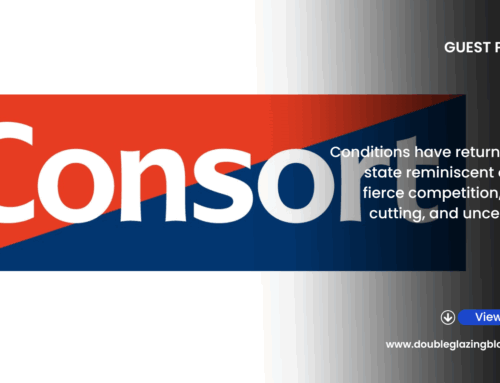We ended last year with warnings about continued price inflation in our sector and we begin the new year with pretty much the same warnings. There is also renewed pressure and fears when it comes to energy prices, with a recent report about eye-watering monthly energy bills coming out of Pilkington.
But even if raw materials prices begin to plateau this year, rising energy prices will keep costs in the fenestration sector going up. Here’s where I see the risk and what we can do to mitigate them.
Energy costs will raise prices
If you ask most people, I think many would say that they expect raw material prices to stop rising, or at least plateau at a higher level at some point this year. Of course, we all thought the same would happen last year and not a single prediction actually came true on that front.
But let’s assume we do for the sake of this particular subject. Firstly, if they do I cannot see them falling back any significant amount. Higher labour costs and rising energy bills will mean fabricators and manufacturers are pinned down at higher levels.
It is the latter of those two factors that are causing the most concern right now. Only a few days ago there was a report out looking at the monthly energy bills Pilkington is having to pay. They have risen from £1m per month to a staggering £8m per month. Think about that for a moment. Energy costs at that company have gone from £12m per year to nearly £100m per year. Having to pay that amount of money just to keep the lights on and the float lines rolling means the business isn’t able to invest in other parts of the business and also creates price pressures that have to be passed down the supply chain.
Herein lies the problem. Even if raw material costs manage to flatline, albeit, at a high level, there is no sign of the energy crisis ending anytime soon. This means fabricators and every manufacturer of every kind is going to pay more and more this year just to keep open. This is going to impact the prices installation companies, and in turn, homeowners, have to pay for their new windows and doors
Businesses, unlike households, are not protected by any form of price cap. Homeowners are paying a lot more for their energy right now, but have been protected to some degree by a cap on costs, even though the price cap itself was raised higher a couple of months ago to prevent more energy companies from going bust. Businesses however have had no shielding from these rises. They have felt every single one, and there have been many, and it is resulting in a crisis where many are warning that factories of all kinds are at a real risk of having to close as they cannot afford their energy bills.
The Government is looking at ways at which it can alleviate some of the pressure. Some weekend reading appears to point to Rishi Sunak favouring more Government loans as a solution to provide businesses more support. Whether or not companies would want to take on more debt at this time isn’t clear, and loans, rather than grants, may cause a less than welcome response. Labour has called for a £600m grant fund with which companies would be able to apply for a portion of those funds. With UK finances the way they are at the moment, I cannot see this being a likely choice right now.
So, what can UK fenestration do to manage the situation which is likely to impact the sector throughout the year?
Pass on energy price rises
We have been told in the past that when it comes to energy, shop around to get the best deals. At the moment, the advice is to stay put, as every supplier is putting their prices up and there are no favourable deals out there to get. So I guess that particular option is off the table for now.
So, in the meantime, those price increases have to be passed down the supply chain. Just as the increases in raw material costs have been during 2021. If you’re a systems company, they have to be passed on to your fabricators. Fabricators need to pass them on to installers. Installers have to pass those on to the homeowner.
We’re not looking at small or insignificant increases at the moment. These cannot be absorbed into a business where the customer doesn’t feel it at their end. That is very unrealistic right now and would hammer profit margins to the point where companies struggle to make any decent money. As with any business model, it is the end-user that has to pay, which in residential fenestration is the homeowner. The same goes for the commercial side of our market.
Over the next few months, we’re all going to continue to get letters from our suppliers explaining what we already know and that they’re adding more to whatever surcharges and price structures they have in place. We’re used to this by now, so this shouldn’t come as a surprise. But I would urge all of you to pass these increases down the chain. Don’t be tempted into absorbing more than you should and putting your profit margins, your absolute lifeline in times of uncertainty, at risk.
Now is also the time, assuming you’re not already doing this, to sell based on quality and service. Trying to win an order on price alone would be foolish when everyone else’s prices, including your own, are going up. For example, I have lost an order on a door to a customer who tells me they have had a price that was £800 cheaper than mine. for clarity, this was a door and sidelight where the sidelight had a couple of opening windows. Assuming the client has told me the truth, I am struggling to figure out if there is any reasonable amount of money being made on the job.
There are a couple of other things to do in the meantime to mitigate higher energy prices. The first is to look at all areas of your business and see where you can cut down on energy consumption. I appreciate this is hard when you’re running a factory that has to consume a lot of energy just to be able to operate. But even small things such as turning off lights where they’re not needed, cutting down on heating where it’s not needed, can all make a difference.
The second thing is to start looking at ways to future-proof your business and invest in solutions that lower your energy costs. You could install solar panels on your roof for example. Install LED bulbs where you can. Look at ground source or air source heat pumps if they are a viable option. Anything you can do which can produce a little bit more energy for yourself and less from the grid is going to be helpful in the long run.
We had to wait out 2021 and the great raw material price surge. It looks like we may have to do the same with the energy price surge as well. How we manage it and distribute the costs is going to be vital in how well we navigate this particular problem.
To get weekly updates from DGB sent to your inbox, enter your email address in the space below to subscribe:
By subscribing you agree to DGB sending you weekly email updates with all published content on this website, as well as any major updates to the services being run on DGB. Your data is never passed on to third parties or used by external advertising companies. Your data is protected and stored on secure servers run by Fivenines UK Ltd.






